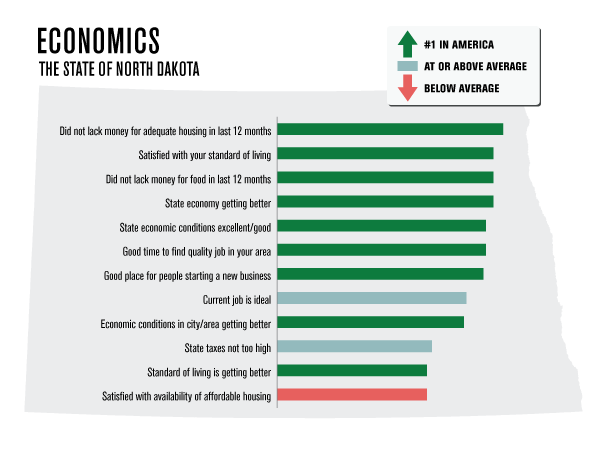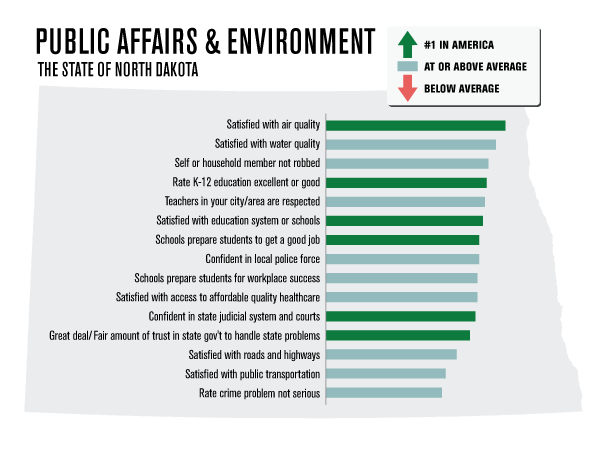WASHINGTON, D.C. -- "Oil boom" is probably the first phrase that comes to mind when one thinks about North Dakota. Yet North Dakotans see their state as much more than oil. They are highly satisfied with their schools, their air quality, their ability to find a quality job, and their overall standard of living. In Gallup's comprehensive survey of all 50 states, North Dakota ranks No. 1 on a variety of indicators spanning economics, public affairs, education, the environment, and well-being. In 2014, North Dakota is a complex, thriving state that is adapting rapidly to the economic and social factors that are transforming this population of roughly 725,000 people.

These findings are based on a special 50-state Gallup poll conducted June-December 2013, including interviews with approximately 600 residents in every state.
North Dakotans are more likely than residents of any other state to say that their state's economic conditions are excellent or good, that the state's economy is getting better, and that they have not lacked money for adequate housing in the last 12 months. In addition, more residents than anywhere else say it is a good time to find a quality job and that their state is a good place for people starting a new business.
To an outsider, the answer seems clear: the North Dakota oil boom has expanded wealth and opportunity to the point that there is a chicken in every pot. To leading officials in North Dakota, the story has its roots in prudent long-term planning statewide that Democrats and Republicans began in the early 1990s. North Dakota Gov. Jack Dalrymple says well before oil was discovered in the Parshall Oil Field in 2006, the state was on its way to economic prosperity. Dalrymple, who served as former Gov. John Hoeven's lieutenant governor, credits his boss with taking these efforts to the next level.
"We needed to get our state economy going," Dalrymple says. "We basically set about creating a state for more opportunities … energy, agriculture, technology, advanced manufacturing, tourism."
In 2000, North Dakota was 38th in personal per capita income, at $25,872. By 2008, that figure had risen to $40,880, or 19th in the nation. According to Andy Peterson, president and CEO of the North Dakota Chamber of Commerce, the growth in advance manufacturing, value-added food processing, and tourism, in addition to traditional bases such as agriculture, accounted for North Dakota's vaulting ahead of other states. It was only in 2009 that oil became a factor in the state's finances, but the groundwork for a boom had already been laid.
"Oil is a very thick frosting on a very nicely baked cake," Peterson says.
Oil had been found in North Dakota before, but Dalrymple, Peterson, and Al Anderson, North Dakota state commerce commissioner, agree that the volume and velocity of the boom was unexpected. Dalrymple says there were 200,000 barrels a day in 2009, compared with 1 million barrels a day now.
"The rapid evolution of the oil industry was not foreseen," says Anderson.
"We had seen oil booms come and go but now the technology has changed," Peterson says. "We didn't realize how much oil was in the ground. We found ways to extract oil that we could never expect."
In addition to oil, success in agriculture, manufacturing, and tourism are contributing factors to North Dakota's having the lowest unemployment in the U.S. for the past four years. Per capita income in North Dakota rose to $57,084 last year, second in the nation to Connecticut at $60,847. The state has added 116,000 jobs since 2000, a job-growth increase of 35.6%. Net migration in the state is up 12.7% since 2000. This onrush of new jobs and workers has strained the housing market. North Dakota residents are fully aware of this, as 61% say they are satisfied with the availability of affordable housing in their state, one of the lowest in the nation.
Anderson says North Dakota has been building 2,000 to 3,000 new housing units per year and that hotel occupancy has dropped from 95% to 65%, as more houses are being built. Dalrymple says his state is building apartment buildings with controlled rents to meet demand.
"I consider that one of the solvable challenges," Dalrymple says. "We're mostly spending money for infrastructure needs."
North Dakotans Give Their Schools an "A"
North Dakotans are not just satisfied with their economy, however. Across the 50 states, North Dakotans are the most likely to rate their K-12 education as excellent or good, to agree that their schools prepare students to get a good job, and to be satisfied with the education system or schools overall.

According to the North Dakota officials, there are various reasons for this high satisfaction with education in the state.
"Sheer volume of school districts helps because there are many local school districts," says Peterson. "Schools are more accessible to students and teachers."
Anderson added that "education has always been extremely important to North Dakota," though he would like to see a continued focus on education for STEM jobs, to keep pace with the growth in the state.
In contrast to their mostly positive -- in many cases, nation-leading -- views about the economy and education, North Dakotans exhibit mixed views on the social climate in their state. While residents were first in the nation in saying they were "treated with respect all day yesterday," and "experienced enjoyment a lot of the day yesterday," they reported low levels of their state being a "good place for racial and ethnic minorities" and a "good place for gay or lesbian people," Gallup reported last year that North Dakota has the lowest percentage of residents in the nation who identify as gay, lesbian, bisexual or transgender.

In offering his view on why his state residents might make these assertions, Dalrymple spoke in general terms about how North Dakota is in a process of evolution.
"There's a tendency for people not being immediately comfortable with new people until they have had a chance to meet them and evaluate them," Dalrymple says. "We're evolving every year and becoming more accustomed to different people and lifestyles."
"We've had a pretty homogenous society in the past," Anderson says. "Ninety percent is probably the white Caucasian split, but minorities are increasing." Anderson added, "I truly believe our rankings will go up. We will adjust and improve. I think it is embraced by the vast majority of people in North Dakota."
Peterson says where North Dakota is located plays a major factor in evaluating newcomers and different lifestyles.
"The rest of the country, especially the coasts, change the pace of life quicker than we do," he says. "Doesn't surprise me that we are slower to change. But I think the state is changing. We reflect the Midwest and I think we're going to change last. But there isn't hostility to these groups. Once you interact with these groups, you realize that people are people."
The North Dakota Experience
North Dakotans are, by and large, satisfied with their state and the direction in which it is going. Certainly the oil boom, after years of strategic economic planning, may be one of the chief contributors to this statewide contentment. North Dakota may now be on the map as an economic power, but it is still a rural state with a large land mass and relatively few residents, with room to grow. Anderson estimated that oil output could rise to 1.7 million barrels per day in the near future. He says North Dakota is now second behind Texas in oil production and that "a few years ago, we saw a 20-year run with oil (but) this can be a 60-year-play."
When asked to sum up the North Dakota experience, each official offered this reflection of the state:
- Peterson: "The North Dakota experience is one of quiet fortitude and self-reliance, pull yourself up by your bootstraps, equal opportunity for all -- at least in our minds, even if it isn't the case. It is about individual responsibility and self-reliance."
- Dalrymple: "North Dakota has been discovered. When I travel around the country, people are no longer clueless about what's going on here -- people coming here and investing here -- it's prospering and there are opportunities here."
- Anderson: "[People] can truly make a difference in North Dakota and they can't necessarily do it everywhere. I've lived in eight states and outside the country. You see a lot of people giving back [in North Dakota]. Our legislators are truly part-time legislators. Everybody matters here and I don't think people get that in a larger community all the time."
North Dakota is evolving -- and its residents are now more positive about their state than any other state in the nation is on economics, well-being, and public affairs.
Survey Methods
Results for this Gallup poll are based on telephone interviews conducted June-December 2013, with a random sample of approximately 600 adults per state, aged 18 and older, living in all 50 U.S. states.
For results based on the total sample of adults per state, the margin of sampling error is ±5 percentage points at the 95% confidence level.
Interviews are conducted with respondents on landline telephones and cellular phones, with interviews conducted in Spanish for respondents who are primarily Spanish-speaking. Each sample of national adults includes minimum quotas of cellphone respondents and landline respondents based on cellphone and landline use in the respective state. Landline and cellular telephone numbers are selected using random-digit-dial methods. Landline respondents are chosen at random within each household on the basis of which member had the most recent birthday.
Samples are weighted to correct for unequal selection probability, nonresponse, and double coverage of landline and cell users in the two sampling frames. They are also weighted to match the state demographics of gender, age, race, Hispanic ethnicity, education, region, population density, and phone status (cellphone only/landline only/both, and cellphone mostly). Demographic weighting targets are based on the most recent Current Population Survey figures for the aged 18 and older U.S. population. Phone status targets are based on the most recent National Health Interview Survey. Population density targets are based on the most recent U.S. census. All reported margins of sampling error include the computed design effects for weighting.
In addition to sampling error, question wording and practical difficulties in conducting surveys can introduce error or bias into the findings of public opinion polls.
For more details on Gallup's polling methodology, visit www.gallup.com.
